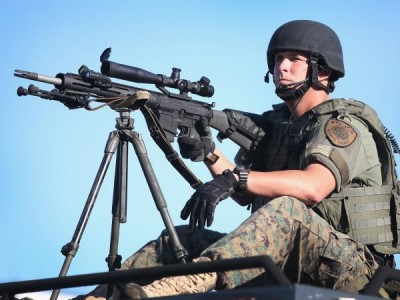The Police, the Military, and Ferguson

“The dominant visual aspect of the story, however, has been the sight of overpowering police forces confronting unarmed protesters who are seen waving signs or just their hands.” Walter Olson, Cato at Liberty, Aug 13, 2014
A terrible vision of what happens when authority goes wrong. This is Ferguson, Mo. in August 2014. Even if the person killed by police, a certain Michael Brown, was a black man; even given the automatic response by authorities that it was a case of justified armed violence, we are left with the same nasty taste: policing in the US has become a beast of terrifying burden, a dark promise of local brutality.
The old problem in US politics has always been reconciling the gibberish of exceptionalism with tensions of corroding imperfection in the political system. The United States may well have some of the best of what is good in political aspiration. (Hard to beat the Bill of Rights and the Madisonian flavour of the constitution.) It also has some of the most fearful responses to matters of security, be it the blight of the race divide, and its twin cousin, that of poverty. Every society struggles with containing its demagogues, and US authorities have managed to stumble badly when it comes to policing its black citizens. They are unruly, and they are unhappy.
The case of Ferguson, with its police forces resembling an armed force by a different name, has implications beyond policing a particular ethnic group. It suggests that protections on the home front are being frittered away in the name of an unruly policing manual, stacked to the brim with military kit. This is the formula of the Los Angeles SWAT team, one advocated by inspector Daryl Gates in the mid-1960s to combat the strife induced by such incidents as the 1965 Watts riots. When trouble arises, call the marines, or at the very least someone similar to them.
Ferguson, with 21,000 people, covers a mere 6.2 square miles. The police budget – coming in at $5.2 m, and boisterous presence, suggests something far more sinister. The Department of Homeland Security, that creature of feigned protectiveness, has been getting police authorities drunk with military grade hardware via “anti-terror grants”.1
Back in 1997, Peter Kraska and Victor Kappeler of Eastern Kentucky University were already noting that policing was moving into a military phase of operation in “Militarising American Police: The Rise and Normalisation of Paramilitary Units”. In such circumstances, threats are magnified and extended. The heavy response is justified in response to inflated threat. This has been a theme for Kraska, who reiterated the “blurring distinctions between the police and military institutions and between war and law enforcement” in 2007.2
Such conditions, simulating urban guerrilla warfare scenarios, localise and intensify conflict. The language of the paramilitary outfit is deployed. “Why armoured vehicles in a Midwestern inner suburb?” asks Walter Olson3 of the Cato Institute. “Why should cops wear camouflage gear against a terrain patterned by convenience stores and beauty parlours?” Then, the question of Ferguson itself: “Why are the authorities in Ferguson, Mo. So given to quasi-martial crowd control methods (such as bans on the street) and, per the reporting of Riverfront Times, the firing of tear gas at people in their own yards?”
In 2012, Olson found how St. Louis County got a Bearcat armoured vehicle, among other items. This, he argues, is often an instance of how military surplus is disposed of. Too much production, not enough use. Indigent local governments, an ever increasing phenomenon on the US landscape, are thrilled at the beefing up of their services with what the military don’t what.
There is no suggestion here of traditional policing in the name of protecting the public. The public is the problem. Individuals such as Matthew Dale Stewart of Ogden, Utah assume when a heavily armed police unit breaks down his door that he is being beset by criminals keen on his life and property. This is the classic rhetoric of war in action – the “war on drugs”, the “war on crime”, dangerous nonsensical terms that populate the language of law and order.
What this has led to is a significant undermining of the 1878 Posse Comitatus Act, which effectively smuggles military involvement via a rather big back door. The military and police find themselves in the same bed of comfort, inflicting the same terrors on a civilian population that should, ideally, be free the ones protected. That is manual no citizen wants.
Dr. Binoy Kampmark was a Commonwealth Scholar at Selwyn College, Cambridge. He lectures at RMIT University, Melbourne. Email: [email protected]
Notes
1 http://www.newstatesman.com/politics/2014/08/michael-brown-ferguson-and-united-states-police-soldiers
2 http://cjmasters.eku.edu/sites/cjmasters.eku.edu/files/21stmilitarization.pdf
3 http://www.cato.org/blog/police-militarization-ferguson-nationwide

